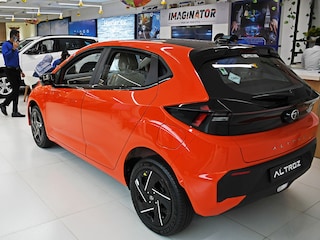GST cuts: Car sales zip, but will it put brakes on EV adoption?
Tax gap shrinks between ICE and electric vehicles, making the former more competitively priced against entry EV hatchbacks


India’s auto industry is suddenly having a blast. After months of lacklustre sales, the world’s third-largest car market is experiencing a revival, thanks to the government’s decision to reduce GST. To add to that, the cuts also came ahead of the festive season, which typically contributes to about 40 percent of the annual sales.
“The GST cut has created a genuine affordability kicker just ahead of the festive window. Passenger cars, two-wheelers, and parts moving from 28 percent to 18 percent GST translates to an effective 7–8 percent relief in on-road prices,” says Harshvardhan Sharma, the group head for automotive tech & innovation at the Nomura Research Institute. “Most OEMs have already passed this on through cuts of up to Rs 3 lakh, layered with festive schemes. As a result, we’re seeing the classic elasticity effect.”
That means buyers who had deferred purchases are returning, dealer inventories are easing, and booking momentum has improved. So much so that, on the day the new taxes came into effect, most auto dealerships saw queues after many years. On September 22, the day the GST rate cuts took effect, Tata Motors reported sales of approximately 10,000 passenger vehicles, with Maruti Suzuki and Hyundai also selling 30,000 units and 11,000 units, respectively. “We expect near-term double-digit volume uplift, particularly in entry and compact segments, with operating leverage offsetting any pressure from lower ASPs,” adds Sharma.
Among others, the tax reduction from 28 percent to 18 percent, coupled with the government’s decision to withdraw a compensation cess that often ranged from 17 percent to 22 percent, to keep a flat taxation rate of 18 percent and 40 percent (for luxury cars), has meant that car prices across the country have reduced ahead of the festive season.
In the process, the entry-level cars, which are often seen as leading the transition from two-wheelers to four-wheelers in the world’s most populous country, have seen significant price cuts. The country's largest carmaker, Maruti Suzuki India, has announced that the prices of the Alto K10, S-Presso, Swift, Dzire, and Brezza are all cheaper by up to Rs 1.29 lakh. On hatchbacks, like the Alto K10 and WagonR, the drop translates to almost 20-24 percent of their ex-showroom price.
Still, that may not be enough to revive the declining trend in small car sales in the country, a growing concern among Maruti Suzuki, the country's largest automaker. While the 7–8 percent effective relief directly addresses affordability, the biggest barrier in the small car space, structural headwinds persist.
“We’ll see a tactical rebound in sub Rs8 lakh hatchbacks and compact sedans, particularly among first-time buyers in Tier-2 and Tier-3 towns and fleet operators,” Sharma adds. “The entry car segment has shrunk from over a million units a decade ago to barely 25,000 last year, while consumer preference has steadily shifted towards compact SUVs. So, this measure can stabilise and revive demand in the short run, but it won’t reverse the long-term premiumisation trend. The bigger uplift will likely be in small SUVs rather than basic hatchbacks.”
Similarly, in the luxury segment, reductions range from as much as Rs9 lakh to Rs30 lakh in some cases. “The start to this festive season has been extremely encouraging,” Shailesh Chandra, president, SIAM (Society of Indian Automobile Manufacturers), and MD, Tata Motors Passenger Vehicles Ltd and Tata Passenger Electric Mobility Ltd, said in a statement. “The recent GST reduction and special festive offers have sparked an extraordinary wave of consumer interest and enthusiasm. In just the first two days, auto dealerships nationwide are witnessing unprecedented walk-ins, a surge in enquiries, and record deliveries across most segments.”
India currently has 34 cars per 1,000 people compared to over 860 per 1,000 people in the US. With growing purchasing power, cheaper access to capital, and a reduction in the tax regime, automakers believe that the country's true potential remains untapped. “While the long-term trends will still hinge on income sentiment and fuel prices, the immediate effect is likely to be a positive uptick in demand, particularly in the entry and mid-price automobile segments,” ratings agency ICRA said in a statement.
Meanwhile, with the significant drop in prices of internal combustion engines and the subsequent surge in demand, the country’s electric vehicle ambitions may also face some challenges. Sales of electric vehicles have been in the slow lane since last year. In the last financial year, sales of electric passenger vehicles in India reached 110,748 units, an 11 percent increase, accounting for just over 3 percent of the country's car sales.
“For EVs, the relative advantage has narrowed but not disappeared,” adds Sharma of Nomura. “With ICE vehicles down to 18 percent GST and EVs retaining 5 percent, the tax gap shrinks from 23 to 13 percentage points. This does make small ICE cars more competitive in sticker price terms, especially against entry EV hatchbacks.”
Still, despite that, the EV momentum remains intact, reckons Sharma. By 2030, about 40 to 45 percent of two-wheelers and 15 to 20 percent of four-wheelers (passenger vehicles) sold in India will likely be electric, according to a report by Bain & Company, while the government wants EV penetration to hit 40 percent for buses, 30 percent for private cars, 70 percent for commercial vehicles, and 80 percent for two-wheelers.
“August saw more than 17,000 passenger EV registrations and two-wheeler EV penetration holding at 6-7 percent,” Sharma says. “The total cost of ownership still favours EVs because of lower energy and maintenance costs, and with broader model launches plus improving charging infrastructure, structural adoption will continue. The implication is that OEMs in the ₹10–20 lakh EV bracket will need sharper price positioning and stronger TCO messaging to sustain demand.”
First Published: Sep 26, 2025, 12:29
Subscribe Now